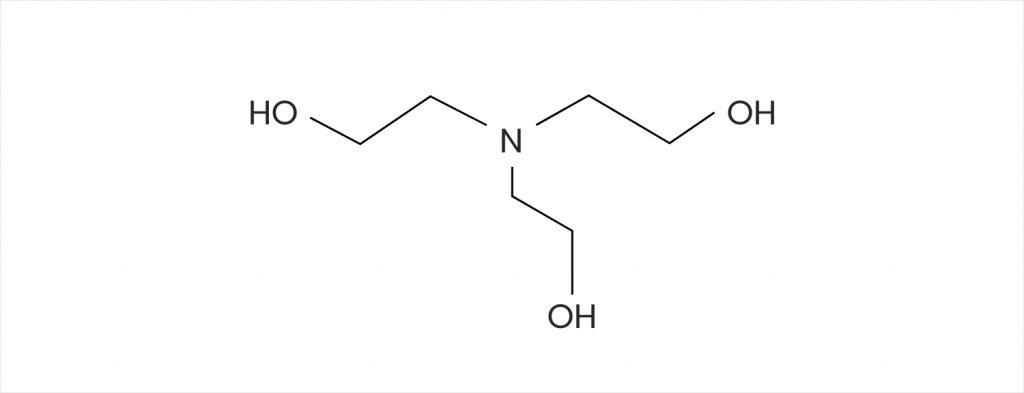What Is Triethanolamine?
Triethanolamine might not be an ingredient you’ve heard of before, or perhaps you’ve seen it on a product label and wanted to know more. Triethanolamine sounds like a complex ingredient, but as is the case with many polysyllabic skincare ingredients, the name is as intimidating as it gets. Triethanolamine is found in skincare and cosmetic products such as moisturizers, eyeliners, mascaras, hair care, and sunscreens. It stabilizes and increases the pH of products to improve the way they feel and interact with the skin. Triethanolamine is also a non-active compound, which means it doesn’t have any effect on the skin; it’s only used to make products more stable and improve texture.
Triethanolamine is a compound with a slight ammonia smell; think of hair dyes. The thick, colorless liquid helps reduce the surface tension of products. It also helps to mix oil and water-based products to create a smooth, stable formulation. Triethanolamine is also involved in controlling the pH of products, making it an excellent ingredient for naturally acidic formulations.
There are two other compounds with similar structures to triethanolamine and they’re often associated with each triethanolamine. The first is diethanolamine, used as a pH adjuster and foam booster in hair conditioning products and the second is ethanolamine, which is used in hair sprays. While these compounds have a similar structure, their differences are significant in determining their function. All three are safe for their approved uses in a review conducted by the Cosmetic Ingredient Review.
The process of manufacturing triethanolamine involves reacting 3-parts of ethylene oxide with 1-part ammonia. Ethylene oxide is a gaseous byproduct of petroleum production, and ammonia is made from gases naturally found in the air that we breathe. This process produces triethanolamine as well as diethanolamine and ethanolamine. This mixture later gets separated and tested for purity. It needs to meet the 99% requirements for purity to be approved.

Triethanolamine
the good: Balances the pH of the product’s formulations and helps to stabilize and thicken products.
the not so good: It does not produce any benefit to the skin. It is used only to improve the feeling of the product.
Who is it for? Any skin type, unless an allergy to triethanolamine has been identified.
Synergetic ingredients: Triethanolamine works with most ingredients and doesn’t change the other ingredients’ properties.
Keep an eye on: Triethanolamine should not be used in products containing N-nitrosating agents. This restriction is due to the potential for interaction between N-nitrosating ingredients. N-nitrosating compounds, like nitrates, mix with triethanolamine to produce carcinogenic nitrosamines. Carcinogens are compounds that have the potential to cause cancer.
What Are The Benefits of Triethanolamine?
Triethanolamine doesn’t provide any benefits to the skin. It is only used in formulations to improve the texture and pH of a product. One reason you may not have heard of triethanolamine is partly due to the lack of benefits it provides to the skin, but also due to the low concentrations present in the product. Most countries regulate the usage of triethanolamine concentrations within the range of 2.5-5%, making it one of the last compounds on a product’s ingredients list.
Triethanolamine is regulated differently in the US and the EU. The EU is known for its conservative approval of skincare ingredients and prohibits the use of many ingredients that are used in the US. Under US regulation, concentrations less than 5% are approved for non-rinse off products and 2.5% in the EU. ‘Non-rinse off’ refers to products such as moisturizers and serums. The term ‘rinse-off’ applies to cleansers and body washes. Rinse off products are under different classifications as they stay on the skin for shorter periods, allowing for varying levels of absorption into the skin. All three of the various forms of triethanolamine meet approval requirements for use in non-rinse off products in both jurisdictions.
What Are Triethanolamine’s Uses in Skincare?
pH and stability
Triethanolamine helps to neutralize ingredients that can increase the acidity of a product. When the acidity of a product is too high, it can cause irritation and risk sensitization. Triethanolamine is used in formulations in order for the benefits to be received without the risk of irritation from acidic ingredients. Due to its structure, triethanolamine is an amphoteric compound, which means it can react as both an acid and a base, helping stabilize the pH to produce a resilient, long-lasting product.
Emulsifies
Emulsifiers help mix oil and water-based ingredients together. It can be difficult to get oil and water-based ingredients to mix well in a formulation and stay mixed. Triethanolamine is used to bind water and oil together to avoid a product splitting or having uneven texture. Triethanolamine’s structure has a hydrophilic side and a hydrophobic side. Hydrophilic means it binds to water and hydrophobic means it binds to oil.
Thickens
Triethanolamine helps to thicken the texture of products. The thickness of a product is purely sensory and helps improve how the product feels on the skin. But how a product feels is an integral part of the formulation process because no one wants to use a product that is lumpy or splits.
Is Triethanolamine Safe?
Some information on triethanolamine sounds frightening, particularly regarding the potential for cancer-causing substances. This is due to the reaction between triethanolamine and N-nitrosating ingredients. However, it is a far less scary ingredient than some articles suggest.
The N-nitrosating ingredients that can interact with triethanolamine in a formulation are highly regulated, making the likelihood of the formation of carcinogens reasonably low. This reaction only occurs with diethanolamine and N-nitrosating ingredients, such as nitrates. Given that triethanolamine breaks down to produce diethanolamine in formulations, any product with triethanolamine needs to comply with the guidelines to omit N-nitrosating ingredients.
There have been rigorous evaluations of triethanolamine’s safety in cosmetics and skincare products, with the most recent review conducted in 2013 by the panel at Cosmetic Ingredient Review. In 2013, an expert panel reviewed the safety profiles determined in 1983, 2010, and 2012. The group found that the 31 related triethanolamine containing ingredients are safe when formulated within safety guidelines to be non-irritating. This review led to the determination that triethanolamine is safe for use when there are no N-nitrosating ingredients present and with concentrations under 5%. They also determined that there is no evidence that it is harmful or can cause long term health concerns.
In the recommendations produced by the Cosmetic Ingredient Review, formulations designed to sit on the skin for long periods such as a moisturizer or mascara should contain less than 5%. This requirement, along with the need for products and containers to be free from N-nitrosating ingredients and nitrates, prevents any potential for carcinogen formation.
Studies published in the International Journal of Toxicology and Reviews of Environmental Contamination and Toxicology researched the safety of triethanolamine. The analysis determined that triethanolamine is not classifiable as cancer-causing. The studies suggest there is inadequate evidence for carcinogenicity in humans. It also concluded that triethanolamine has low toxicity for humans. There is a misconception about how these conclusions are interpreted. It is generally thought that “inadequate evidence” means there hasn’t been enough research; however, it merely means that the studies conducted did not produce any indication that it is carcinogenic.
Allergies
There is some evidence that at high concentrations, (greater than 5%), triethanolamine can cause some irritation on the skin. While this reaction is rare, hypersensitive skin types should be aware of the potential irritation. In rare cases, products containing triethanolamine may be contributing to sensitivity.
Some information on triethanolamine in the media describes negative effects on the respiratory system, skin, and eyes. These effects are based on studies conducted on the manufacturing of triethanolamine. This process works with high concentrations of triethanolamine and can be at risk of vaporization in warmer climates. When improper safety protocols are in place, there is the potential for adverse reactions. Symptoms may include mild irritation to eyes, respiratory irritation, and cumulative toxicity These symptoms are the result of exposure during the manufacturing process and are addressed by adhering to safety protocols. When considering skincare, the concentrations are significantly lower, so risks are minimal.
Other Uses of Triethanolamine
Triethanolamine has other uses. It is used as a lubricant in the textile industry to soften animal hides, and as an alkalizing agent in the pharmaceutical industry.
References:
Cosmetic Ingredient Review, ‘Review of Triethanolamine, Diethanolamine, and Ethanolamine’ CIR.
Fiume, M, et al. 2013. ‘Safety Assessment of Triethanolamine and Triethanolamine-Containing Ingredients as Used in Cosmetics’. International Journal of Toxicology. vol. 32, pp. 595-815.
Knaak, J, Leung, H, Stott, W, Busch, J & Bilsky, J, 1997. ‘Toxicology of Mono-, Di, and Triethanolamine’, Reviews of Environmental Contamination and Toxicology, vol. 149, pp. 1-86.
Kraeling, M & Bronaugh, R, 2003. ‘In Vitro Absorption of Triethanolamine Through Human Skin’, Journal of Toxicology: Cutaneous and Ocular Toxicology, vol. 22, is. 3.
National Center for Biotechnology Information, ‘Triethanolamine’. PubChem Database, accessed on June 16, 2020.







